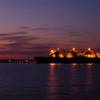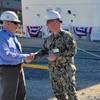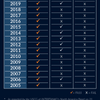ABS has released a report on "Technical Analyses Related to
the Prestige Casualty.” It is available for download from the ABS website (www.eagle.org). The report assesses vulnerabilities that may have theoretically existed in the hull structure at the time of the casualty. It also addresses potential external forces
that could have turned that vulnerability into a failure of the side shell,
leading to the initial flooding of the starboard Nos. 2 Aft and 3 wing
tanks.
"It is almost certain that the initiating cause of the damage to the
Prestige will never be definitively identified," said ABS President Robert
D. Somerville. "The physical evidence was either destroyed or lost during
the subsequent six day ordeal that the vessel went through after it was
denied access to a sheltered area. That leaves the inquiry in the realm of
hypotheses and speculation. The intent of the extensive, rigorous technical
analyses that have been undertaken by ABS is to explore these various
theories in the hope that some weighting can be given to the validity of
each."
The ABS President stressed the importance the classification society has
attached to the investigation. "The livelihoods of thousands of people, and
the pristine coast of Galicia have been devastated by this accident," he
said. "And in the 25 years prior to the sinking of the Prestige only one
ABS classed tanker had been lost at sea due to structural failure with that
incident occurring during a severe typhoon in the Pacific Ocean. It is for
these reasons that we considered it imperative that ABS look at all
possible contributing factors to the loss of the Prestige to determine if
any further strengthening of our class requirements should be considered."
The technical analyses included consideration of:
· Static load determination for the hull structure
· Wave and ship motion induced load component determination
· Structural analysis of the hull structure using finite methods
· Determination of hull girder strength
· Fatigue analysis of structural details
· Contact damage assessment due to lightering operations
· Effects of welding imperfections and residual stress
· Breaking wave load analysis on side structure.
These analyses found, inter alia, that the as-built hull structure of the
Prestige fully satisfied both the 1973 ABS Rule requirements and the 2003
ABS Rule and IACS Unified Rule requirements for hull girder section moduli
and hull girder strength. The vessel was properly loaded, had more than
adequate hull strength for the reported conditions at the time of the
casualty and would not have failed by either yielding or buckling, assuming
no weakened condition existed in the hull structure.
The analysis also confirmed that, in the weather and sea conditions
prevailing at the time of the casualty, the maximum impact pressure that
could have been imposed on the vessel's side shell from breaking wave
impact load was significantly less than the impact strength of the side
shell.
"While intuitively ABS believes the most likely failure mode leading to the
initial flooding of the starboard tanks was a combination of a weakened
section of the vessel's structure, coupled with severe wave impact force,
our analyses of potential factors could neither prove nor disprove the
contribution of any of these," the Report states. "In the absence of
physical evidence or eyewitness testimony, it may never be possible to
pinpoint the contributing factors which led to the initial breach of the
shell. This is unfortunate since it will both prevent specific corrective
action and continue the speculation regarding the specific cause of the
initial flooding."
In assessing the many possible contributing factors the one that has been
identified by the ABS analysis as warranting further consideration is the
possible deformation or fracture of a section of the side shell plating or
supporting structure due to the lightering activities of the Prestige in St
Petersburg between the time of the last annual survey and its departure on
its final voyage.
"While no evidence currently exists that the Prestige did suffer such
damage," the Report notes, "ABS does have damage survey reports describing
similar damage that was experienced after lightering operations in 1989 by
a sister ship of the Prestige. While ABS is hesitant to define lightering
damage as the probable cause of the initial casualty, it does remain a more
likely contributor than any of the other factors."
Although the principal focus of the ABS technical analyses has been
directed towards identifying the initiating cause of the damage,
consideration was also given to the ultimate hull failure and resulting
sinking of the tanker. Rigorous analysis of the vessel in the damaged and
counter flooded conditions clearly showed that the vessel retained
sufficient hull girder strength and buoyancy to remain intact and afloat if
not subjected to sustained additional dynamic wave loads. However, its
ability to withstand further hull damage was severely limited.
The analysis confirms that, if the vessel had been afforded the protection
of a sheltered area, the hull structure had substantial reserve strength
against the total vertical bending moment at the time and would not have
broken in two.
"The sustained dynamic wave loading for the period while the Prestige was
under tow, subsequent to the initial casualty, was the direct cause of the
ultimate disintegration of the hull structure and subsequent sinking of the
vessel," states the Report.
The Report concludes that, "Had the vessel been afforded a safe refuge,
protected from the wave bending moments and dynamic forces experienced in
the open ocean, it would have remained intact and afloat for a sustained
period, certainly long enough to lighter the oil cargo off the vessel and
prepare it for subsequent repair."
It is for that reason that the single definitive recommendation issued by
ABS as a result of its rigorous technical investigation into the casualty
is that "the international community of nations establish guidelines for
the safe refuge of damaged vessels in order to prevent another damaged
vessel becoming the cause of a regrettable and avoidable pollution event."
Sponsored Content
ALMACO Group Completes Extensive Refurbishment on The Aroya

March 2025
 Read the Magazine
Read the Magazine

 Read the Magazine
Read the Magazine
This issue sponsored by:

Sailing Towards a Greener Future. Grain de Sail’s Vision for Wind-Powered Cargo Ships
Subscribe for
Maritime Reporter E-News
Maritime Reporter E-News is the maritime industry's largest circulation and most authoritative ENews Service, delivered to your Email five times per week










